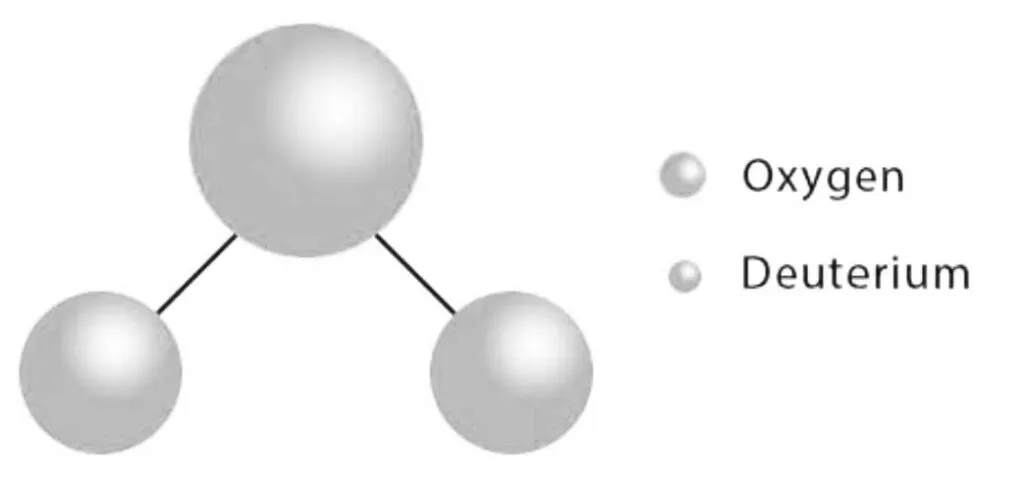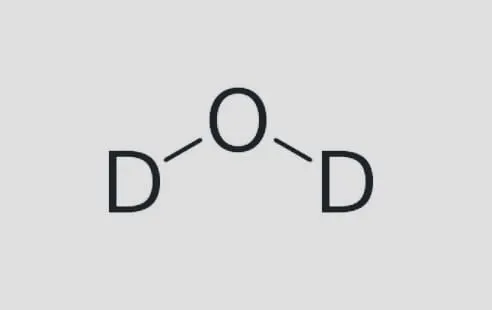What Is Deuterium Oxide (D₂O)?
Deuterium, a heavier isotope of hydrogen that is represented by the letters “2H” or “D,” is a component of the molecule known as heavy water or Deuterium oxide and has the chemical formula D2O.
Since the atomic mass of deuterium is greater than that of protium, it has a higher molar mass than ordinary water. Due to this, Deuterium oxide (D2O) differs slightly from ordinary water (H2O) in terms of its chemical and physical characteristics.

Types of heavy water
One protium, one deuterium, and one oxygen atom make up the type, which has the formula HDO.
Water molecules frequently trade hydrogen atoms with one another. This suggests that water samples containing both protium and deuterium can contain HDO.
In this sample, HDO, D2O, and H2 are in a dynamic equilibrium.
Semi heavy water
- One protium, one deuterium, and one oxygen atom make up this type, which has the formula HDO.
- Water molecules frequently trade hydrogen atoms with one another. This suggests that water samples containing both protium and deuterium can contain HDO.
- 50 percent semi-heavy water, 25 percent light water, and 25 percent heavy water make up a sample of water with an equal amount of protium and deuterium.
- In this sample, HDO, D2O, and H2 are in a dynamic equilibrium.
Heavy oxygen water
- Heavy-oxygen water is defined as water that contains heavier isotopes of oxygen, like 17O and 18O.
- Due to the fact that it has a larger density than ordinary water, it is referred to as a type of heavy water.
- The 18F isotope of fluorine is created using heavy-oxygen water that contains the oxygen isotope 18O . Radiopharmaceuticals and radiotracers both use it.
Tritiated Water
- It is a radioactive variety of water that uses tritium (3H) rather than protium.
- It is frequently referred to as super-heavy water and has the formula T2.
- The amount of water in a body can be calculated using tritiated water.T2O has a density of 1.85 g/mL and a molar mass of 22.03 g/mol.
Physical Features
- At standard temperature pressure(STP), deuterium oxide appears colorless.
- It is a colorless liquid at ambient temperature.
- An ice cube produced of deuterium oxide will sink in ordinary water because its density is around 11% more than that of water.
- When regular water and heavy water are combined, the result is homogenous.
Chemical Features
- Due to variations in their atomic masses, the hydrogen isotopes have various chemical properties.
- High concentrations of deuterium can have a negative impact on biological systems by altering the solvent characteristics of water.
- in comparison of D2O and H2O, normal water dissociates even more.
- At a given temperature, the amount of D+ ions in a sample of D2O is typically less than the amount of H+ ions in a sample of H2O.
Uses Of Heavy Water
- Deuterium oxide, as previously established, is a crucial component of nuclear reactors, where it serves as a coolant and a neutron moderator. Here are a few more significant uses for it.

- As a tracer to investigate photosynthesis’ role in respiration.
- Nuclear magnetic resonance spectroscopy, which examines the magnetic fields surrounding atom nuclei, using D2O.
- In the nuclear reactor as a moderator to delay the neutrons. Because it can slow down the quick neutrons, allowing them to interact with the 235U isotope rather than the 238U isotope.
- A blend of D2O and heavy-oxygen water is used to measure the metabolic rate in both humans and animals.
- Deuterium is abundantly found, absorbs a neutron to generate tritium, the active component used in controlled nuclear fusion reactions.
Read More About:

